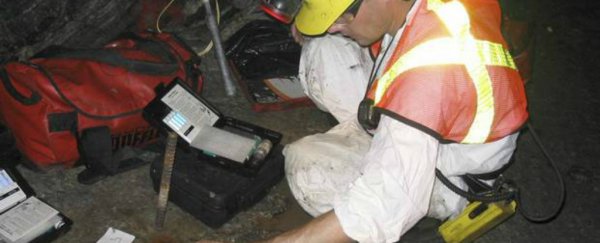Researchers have found evidence that the world's oldest water, found deep below ground in northern Ontario, could harbour microbial life that's totally 'alien' to life on the surface.
The water was discovered 2.4 kilometres deep in a mine back in 2013, and it's estimated to have been cut off from the surface for up to 2.64 billion years - almost half our planet's history.
Now researchers have shown that the water has its own self-sustaining life-support system, which means it's possible that exotic life has been evolving under there, separately to life on the surface - and without sunlight or atmospheric oxygen - for billions of years.
They've also found indirect evidence of an unidentified form of microbial life - although we're a long way off verifying that directly.
For now, all we know is that it's possible that microbial communities have been evolving in parallel to life as we know it, deep below the planet's surface. And this suggests that the same thing could be happening on Mars.
"This continues to open up our idea of how much of this planet is habitable," Barbara Sherwood Lollar, one of the researchers from the University of Toronto, told Ivan Semeniuk from The Globe and Mail. "And it speaks to the habitability of Mars as well."
Researchers had already found microbes living in similar ancient water that runs through the cracks of ancient rocks deep below the ground in South Africa.
But the Canadian water has been isolated for 10 times longer - since before the Cambrian explosion that saw most of our modern species evolve - which means there's been plenty of time for strange life to evolve down there.
To figure out whether that was even possible, a team of researchers collected samples of the ancient water from boreholes at the Kidd mine, and tested its mineral content.
What they were interested in was whether or not it contained sulphur.
Pretty much all life on Earth gets its energy from chemical reactions that shift electrons from one place to another. For us, that involves getting electrons from our foods and shifting it onto the oxygen that we breathe.
But some types of bacteria have evolved alternate pathways - they use hydrogen gas the source of electrons, and a form of dissolved sulphur known as sulphate, as the destination for the electrons.
The researchers already knew that there was plenty of hydrogen in Canada's ancient water, and the latest research showed there's also enough sulphate to sustain life.
The sulphur comes from a mineral called pyrite in the surrounding rocks, and is eventually broken down by the rocks' natural radioactivity and dissolved into the water. And according to the team's measurements, that's been happening since the water first became isolated, creating a long-term habitable environment.
The team then took things one step further and calculated that the amount of sulphate was 100 to 1,000 times less than would be expected in the water supply - which lead researcher Long Li from the University of Alberta to suggest that low levels of microbes are already existing in the water and using up the sulphite.
"The wow factor is high," said Li in a press release.
This is just one hypothesis, however, and no microbes have been detected in the water so far. But the team is now working with microbiologists to look for any traces of life.
Regardless of whether or not any life exists in Canada's ancient water, the find is still hugely important for our understanding of where to look for life both here and on other planets.
"The thing that's special is that the sulphate is being generated by radioactive decay," Alex Sessions, a geobiologist at the California Institute of Technology, who wasn't involved in the study, told The Globe and Mail. "That's huge."
"Because this is a fairly common geological setting in early Earth as well as modern Mars, we think that as long as the right minerals and water are present, likely kilometres below the surface, they can produce the necessary energy source to support the microbes," added Li in a press release.
"I'm not saying that these microbes definitively exist, but the conditions are right to support microbial life on Mars."
The research has been published in Nature Communications.
